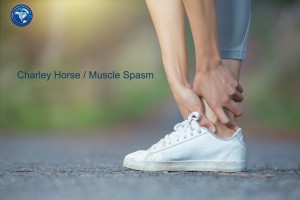
Charley Horse is another name for muscle spasm – when a muscle suddenly tightens up on its own resulting severe pain.They’re common in your legs, often occurs during exercise and at night. It commonly affects the calf muscle at the back of the lower leg, but it can also occur in the foot and, occasionally, in the thigh.The sudden and uncontrollable spasm can often be brief, but it can last for several minutes or up to 10 minutes.
Causes:
Doctors do not know exactly why muscle cramps happen when a person is exercising or when they have no other medical conditions.
Things that can trigger a charley horse include:
- Poor blood flow
- Working your muscles too much
- Not stretching enough
- Being active in high temperatures
- Dehydration
- A lack of magnesium and/or potassium in your diet
- A problem such as a spinal cord injury or a pinched nerve in your neck or back
- Kidney disease
- Muscle cramps are also a side effect of some drugs – diuretics, raloxifene (Evista), or statin drugs
Risk factors for charley horses
Muscle spasms can happen to anyone, at any age. And a charley horse can occur at any time of the day or night.
Charley horses do tend to occur more often among people in the following groups:
- athletes
- infants
- older adults
- people who are obese
- people taking certain medications like diuretics, raloxifene (Evista), or statin drugs
- people who smoke
People who are obese are more likely to experience charley horses because of poor circulation in their legs. Athletes often experience charley horses because of muscle fatigue or overuse.
Charley Horse Diagnosis
The occasional charley horse doesn’t require an official medical diagnosis. However, your doctor should investigate frequent, recurrent muscle spasms. This would apply if a charley horse occurs more than once a week without an adequate explanation.
Your doctor can usually make a diagnosis based on your medical history and a physical examination.
The doctor will more than likely ask about their symptoms, including:
- what the cramping is like and where it occurs
- when the cramps happen and for how long
- how severe or regularly the cramps occur
- whether they have started recently
A doctor is likely to ask about the person’s exercise habits, diet, and any other symptoms, medical problems, or current medications, as well.
Treatment
There is little evidence that medical intervention can help cure or reduce muscle cramping.
However, when a muscle is cramping, and a person experiences a charley horse, the following action may help them find some relief:
- If you get a charley horse in your calf or in the back of your thigh (hamstring), put your weight on the affected leg and bend your knee slightly. Or sit or lie down with your leg out straight and pull the top of your foot toward your head.
- For a cramp in the front of your thigh (quadriceps), hold on to a chair and bend the knee of the affected leg. Pull your foot up toward your buttock.
Massage, a bath with Epsom salts, or a heating pad can relax the muscle. To fight pain, use an ice pack or take an over-the-counter medication like ibuprofen or naproxen.
In most cases, the charley horse will stop within a few minutes. But if you get them often and for no clear reason, consult your doctor
- In severe cases, your doctor may prescribe antispasmodic medication. Also, physical therapy can help you cope with muscle spasms and prevent further complications.
- In extreme cases, you doctor may recommend surgery. If other treatments fail, surgery can enlarge the space around a nerve to relieve pressure. This may help if nerve compression causes your spasms.
Preventing charley horses
Once you identify the cause of the occasional charley horse, symptoms are generally easy to prevent. Take these steps to help avoid future muscle spasms:
- Stretch before and after exercise.
- Avoid exercising the same muscles on consecutive days.
- Weight loss for people with excess weight
- Changing to different more comfortable footwear
- Do not exercise in severe weather.
- Drink water throughout the day.
- Drink beverages that contain electrolytes, such as Gatorade.
- Stretch before going to bed
- Don’t smoke.
- Limit Alcohol intake
Takeaway
Charley horses are common and can occur in any muscle at any time. They’re usually treatable and can sometimes be prevented.
Any pain caused by a spasm won’t typically last more than a day. However, if you experience charley horses frequently, talk with your doctor about treatments.

Post a comment